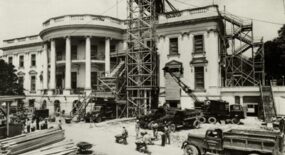TEACHER'S TEXT:
The White House lends itself to an exploration of colors and shapes. The rooms that visitors see on the first floor are rectangles, squares and ovals. There are also arches and a semi-circular porch. Bold colors are represented in the paint, wallpaper, draperies and furniture upholstery of the rooms. To illustrate this point, three rooms are actually known as the Green Room, the Blue Room and the Red Room.
The original designer of the White House, an Irish-born builder named James Hoban, drew a floor plan of the first floor that still survives today. Hoban gave variety to the plan by incorporating (1) a large rectangular East Room suited for large groups of people gathered for receptions; (2) a somewhat smaller rectangular State Dining Room, for public dinners; (3) two square parlors, the Green Room and Red Room; and (4) the oval Blue Room, which was a space for greeting the president and first lady. He expected visitors to move from space to space and enjoy the changing shapes of the rooms. One of the most famous rooms, the president’s Oval Office, was designed in the 20th century and is part of the West Wing.
By examining architecture, students can readily see how shapes play a part in their everyday lives. They can begin to see when certain shapes are more practical than others — a large gathering room is more likely to be rectangular than square. They can also see when creative uses of shapes — like ovals, triangles and arches — add to the beauty of a space. The White House is a building that offers many such lessons.
Download Lesson Plan
Download Activities
Objectives
By successfully completing this lesson and accompanying activities, students will:
- Identify two-dimensional shapes as they are represented in the White House.
- Recognize colors as they have been applied within the White House.
- Compare and measure lengths and widths.
Curriculum and Evaluation Standards for School Mathematics
"The Colors and Shapes of the White House" conforms to standards established for grades K-4 by the National Council of Teachers of Mathematics, Reston, VA, 1989.
- In grades K-4, the mathematics curriculum should include two- and three-dimensional geometry so that students can
- Describe, model, draw, and classify shapes,
- Investigate and predict the results of combining, subdividing, and changing shapes
- Develop spatial sense
- Relate geometric ideas to number and measurement ideas
- Recognize and appreciate geometry in their world.
LESSON PLAN:
Once you go inside the White House, it is not very white! Three of the rooms are so colorful that they are called the Green Room, the Blue Room, and the Red Room. And it is not just the walls that are colorful. Look at the carpets, the drapes on the windows, the couches and the chairs.
Why are these rooms so colorful? Presidents long ago used these colors in the rooms and most presidents after them did, too. Thomas Jefferson, our third president, had a green carpet in the "Green Room." President Martin van Buren started using blue to decorate the Blue Room in 1837. When John Tyler was president in the 1840s, people started calling the Red Room red. Today, when these rooms are decorated, these colors are still used.
You can also find many shapes inside and outside the White House.
Rectangles:
The State Dining Room and East Room are rectangles.
The president and first lady have always had parties and dinners in the White House. In the State Dining Room, 140 people can sit down for dinner.
In the East Room, even more people can sit and listen to a concert or a speaker. Big Bird sang with the Marine Band in the East Room!
The Cross Hall is also a rectangle. A hall is a place where many people walk from one room to another. Like all the rooms in the White House, many changes have been made over the years. Here is the Cross Hall in 1889. Another hall at the same time had many shapes on the floor. The Entrance Hall had pretty tiles on the floor made of squares, circles and diamonds.
These big rooms are rectangles. If you think about your living room or dining room in your house, it is probably a rectangle too. The biggest rooms in buildings are usually rectangles.
Squares
The Green Room and Red Room are squares. Small groups of people can meet here. Presidents and first ladies had tea here. Thomas Jefferson ate dinner in the Red Room. These rooms are sometimes called parlors.
Ovals
There are four oval rooms in the White House. An oval is like an egg. It is not a perfect round circle. It is a little flat on two sides, but has no sharp corners. If the president invited you to dinner or a party, he might meet you in the oval Blue Room. You would shakes hands there and then go to another room that was big enough to hold everyone. A long time ago, people would stand near the walls in a circle. The president would speak to each person as he walked around the circle. There is another oval room above the Blue Room. This is called the Yellow Oval Room. President John Adams had his first reception in this room.
The president works in the Oval Office. He can pick his desk, chairs, couches, and the pictures that hang on the wall. The president has meetings and meets visitors here. He also has another office on the second floor of the White House.
Other Shapes
There are other shapes in the White House. They help make the building more beautiful.
Colors and shapes are important parts of the White House. They are important in all buildings. Now that you have seen colors and shapes in the White House, you can look for them in stores, schools, churches, and other houses.






































































